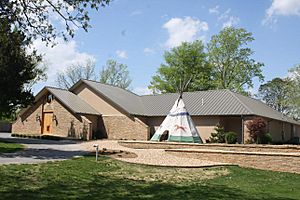Museum of Native American History facts for kids
 |
|
| Established | 2006 |
|---|---|
| Location | 202 SW 'O' Street Bentonville, Arkansas |
| Type | Native American museum |
| Founder | David Bogle |
The Museum of Native American History is a special place in Bentonville, Arkansas. It's a museum that teaches about the history, art, and culture of Native American people. It's a non-profit museum, which means it's not run for money. It's also easy for everyone to visit, including people with disabilities.
The museum was started in 2006 by David Bogle. He is a local businessman and a member of the Cherokee Nation. The museum's main goal is to help visitors learn about the many different Indigenous cultures of the Americas. They do this by showing amazing art and tools from both ancient and more recent times.
The museum wants to help everyone understand the human experience within these cultures. It's a place where you can use your imagination to explore. The exhibits are set up in time order, so you can see how Native American art and tools tell their stories. The museum invites you to discover the creations of these diverse cultures.
The museum has artifacts from all over the Americas. These items cover 24,000 years of history! Instead of focusing on just one tribe, the museum shares the wider history of Native Americans as a whole. The exhibits start around 22,000 BC and go up to about 1930 AD.
It's free to visit the museum! In 2022, about 34,000 people visited. The number of visitors has continued to grow since then. The museum is often listed as the second most popular attraction in Bentonville. Only the Crystal Bridges Museum of American Art gets more visitors.
Outside the museum, there's a fun arrowhead hunt for all ages. You can search for arrowheads around the teepee on the museum grounds.
Contents
How the Museum Started
David Bogle, who is a member of the Cherokee Nation, started collecting Native American items when he was young. He bought his first arrowhead collection from his scoutmaster. Over time, his collection grew very large.
He wanted to share his collection and teach people more about how Native Americans lived. This led him to open the museum in 2006. It first opened in a house that was changed into a museum. The museum also has items from the University of Arkansas Museum, which closed in 2003.
The museum moved to its current building in June 2008. It has grown three times in the last ten years. Now, it is 13,500 square feet, which is a lot of space for its growing collection. In 2015, Jim and Nancy Blair gave the museum 1,500 items from Meso-America. These new items came from Southern Mexico, Central America, and South America.
Native American Celebrations
The museum has hosted an annual Native American Cultural Celebration. This event includes concerts, workshops, speakers, and movie showings. The celebration in Fall 2021 had over 20,000 visitors. People joined both online and in person. In 2022, the 5th annual celebration was the first to be held both in person and online.
School and Group Visits
The museum has special parking for buses, which is great for school and group visits. There's also a new overflow parking area. The parking, restrooms, and museum are all easy to access for everyone. The museum offers scavenger hunts for groups. Kids can also enjoy a free arrowhead hunt.
Explore the Permanent Galleries
The Museum of Native American History has several permanent galleries. Each gallery focuses on a different time period.
Paleo Period
This gallery shows the earliest times of humans in the Americas. It covers from about 22,000 BC to 8,000 BC. When you enter, you'll see "Tusker." This is a real Woolly Mammoth skeleton from Siberia!
Archaic Period
This gallery shows a time when people started to become "Hunters and Gatherers." This was after the large animals, called Mega-Fauna, had died out. People began living in small villages and finding their own food. This gallery has many examples of tools and weapons from the Archaic period. You can see Atl-atl specimens, which were tools used for throwing spears.
Woodlands Period
The Woodlands period lasted from 1,000 BC to 900 AD. During this time, people started growing crops. They also formed larger communities. This period is known for the development of earthen mounds used for burials and ceremonies.
Mississippian Period
The Mississippian Period was from 900 AD to 1450 AD. During this time, larger villages and towns grew. People had more resources, which led to beautiful pottery. Some of the most detailed pottery samples we have today are from this period.
This gallery also has the Sweetwater Biface. It's known as the thinnest flint artifact ever found.
Historic Period
The Historic period lasted from 1650 AD to 1900 AD. This time includes when Native Americans first met and interacted with Europeans. It continues almost up to modern times.
Pre-Columbian Gallery
The Pre-Columbian Gallery focuses on artifacts from Mexico, Central America, and South America. These items are from before the time of Columbus. You can see items from the Aztec, Maya, and Inca peoples.
Images for kids


